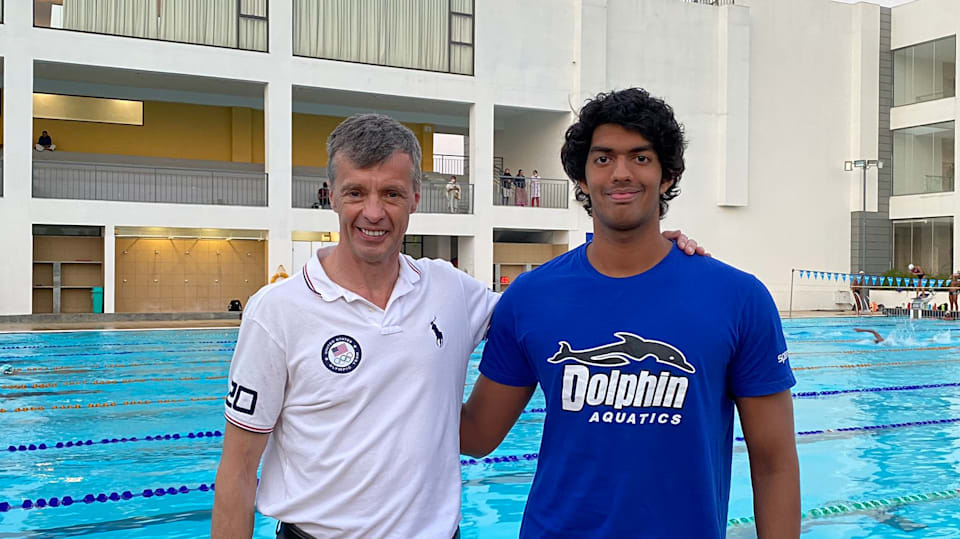Humans are just learning how to swim faster: Michael Phelps' former associate 'Dr. G'
The renowned sports scientist, who has worked with Michael Phelps, reveals how bio-mechanics is pushing human limits in the sport

“Have you seen a fish?” Dr. Genadijus Sokolovas asks. “This little fish is twice as fast as the fastest swimmer in the world. It is built for swimming, we are not.”
That’s where Sokolovas, who prefers to be called Dr. G, comes in. A former middle-distance swimmer and pentathlete, the Lithuanian has dedicated his life to analyzing human performance in water, and how to better it. He was the man hunched behind the computer, zoning in on the details, as Michael Phelps tore away one world record at a time in the pool.
Sokolovas, a renowned sports scientist and biomechanics expert, worked with USA Swimming for eight years, beginning in 2000, and helped Phelps and his illustrious peers, like Dara Torres, become stronger, faster, more efficient in the water.
Phelps retired at the age of 31 as the most decorated Olympian of all time with 28 medals, 23 of them gold, eight of them at the Beijing Games. Sokolovas was part of the American’s journey from a teenage prodigy in Sydney to bona fide legend in Beijing, where he fellow American Mark Spitz’s record for the most number of gold medals at a single Games.
Like Phelps, Sokolovas sees no limitations, only possibilities.
“Our research shows that we are far away from reaching the limits in swimming. Even less talented athletes can swim fast and break world records,” Sokolovas, who was in Bangalore last week to work with Indian swimmers at their national camp, told the Olympic Channel.
“Humans are just learning how to swim faster.”
“Once we started to measure bio-mechanical parameters, we understood that athletes can swim much faster than current world records,” added Sokolovas. “My analysis shows that even with current knowledge of technique swimmers can swim about three seconds faster than world records over 100 meters. It seems impossible, but I am sure we will get there.”
During his time at USA Swimming, Sokolovas developed many breakthrough programs to help swimmers push the boundaries.
One of his most important contributions to the sport was the Swim Power Test, which “quantifies swimming technique by measuring speed and force 60 times per second in real time.” Every stroke, movement, breath can be analysed and tweaked for a better performance.
“We are using multiple mathematical models in swimming and some other sports. Models include long-term adaptation, swimming technique, recovery,” Sokolovas explained. “Phelps and his coach Bob Bowman used our tests for many years, even when he was world record holder. And he continued to improve. It shows that our tests are beneficial. Changes in technique, training, recovery allow swimmers to improve. Every detail is important.”
While he is a man of finer points, the big picture is not lost on Sokolovas. Having worked with swimming champions around the world, he believes there are a few attributes that they all share.
“Swimming champions can dedicate many years for hard training,” he said. “They are willing to train more than others, they are eager to learn new things, they can spend months of hard work until seeing improvements and they love to use new technology and training equipment.”
India, a sleeping giant in the sport, is only now waking up to the new-age technology.
Even though none of the Indian swimmers have qualified for the Olympics yet, the country has a vibrant bunch of swimming talent.
Six Indian swimmers -- Virdhawal Khade (50m freestyle, 22.44s) Sajan Prakash (200m butterfly, 1:58.45), Srihari Nataraj (100m backstroke, 54.69s), Kushagra Rawat (800m freestyle, 8:07.99), Aryan Makhija (800m freestyle, 8:07.80) and Advait Page (800m freestyle, 8:00.76) – have achieved the lower ‘B’ qualifying mark. The kicker is, no Indian has ever qualified for the Olympics with a ‘A’ time, which guarantees them a place at the quadrennial event.
“I expect the top swimmers should make the A cut,” Sokolovas said of the Indian hopefuls.
“Hopefully, there will be multiple Indian swimmers making the ‘A’ cut next Olympics. The age of peak performance, for sprinters, is around 24-25 years old. I would expect that these swimmers will be way more competitive next Olympic cycle than this one.”
The Swimming Federation of India has entered a long-term contract with the sports scientist and will work with him right from a talent identification process to an elite athlete program.
It appears as though as thirst for science is what will help propel Indian swimming into the fast lane of the sport.
